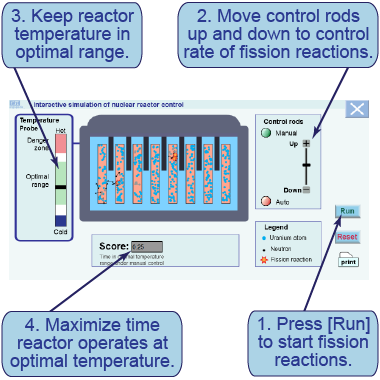|
| Essential questions | | How are chain reactions necessary for nuclear power?
How do control rods work in a nuclear reactor? | |
|
Nuclear reactions produce the energy that is at the heart of nuclear power. Most nuclear reactors use uranium as the fuel for the reactions. When a uranium nucleus is struck by a neutron, the nucleus fissions. Each nuclear fission reaction releases two neutrons, which cause fission in two nuclei, releasing four neutrons, and so on starting a chain reaction. In this investigation you will investigate the nuclear chain reaction inside a reactor and control the reaction rate using control rods. Control rods are made out of a material such as cadmium that absorbs neutrons. The control rods move in and out of the reactor core to allow fewer or more reactions by regulating the number of fission-producing neutrons. 
|
Controlling the nuclear chain reaction inside a nuclear reactor

- Launch the interactive simulation. Press [Run] to start fission reactions by allowing neutrons into the reactor.
- Move the control rods up and down to control the nuclear chain reactions.
- Monitor the temperature probe to keep the reactor within its safe operating range as you adjust the control rods.
- Note the length of time you kept the reactor within the optimal temperature range.
- What is required to start the first nuclear reaction? Write down the nuclear reaction equation to back up your answer.
- What happens to the chain reaction when the control rods are fully inserted into the reactor? What happens when the rods are fully removed?
- What happens to the temperature inside a nuclear reactor if the control rods are fully removed? How could this be a safety issue?
- Determine the optimal position of the control rods to produce a steady power output for the nuclear reactor. Explain why this position makes sense to control a nuclear chain reaction.

|
|
In this interactive simulation, you will control the nuclear reactions occurring inside a nuclear power plant using the control rods. Moving the control rods in and out of the reactor core changes the rate at which the nuclear reactions occur.
|

